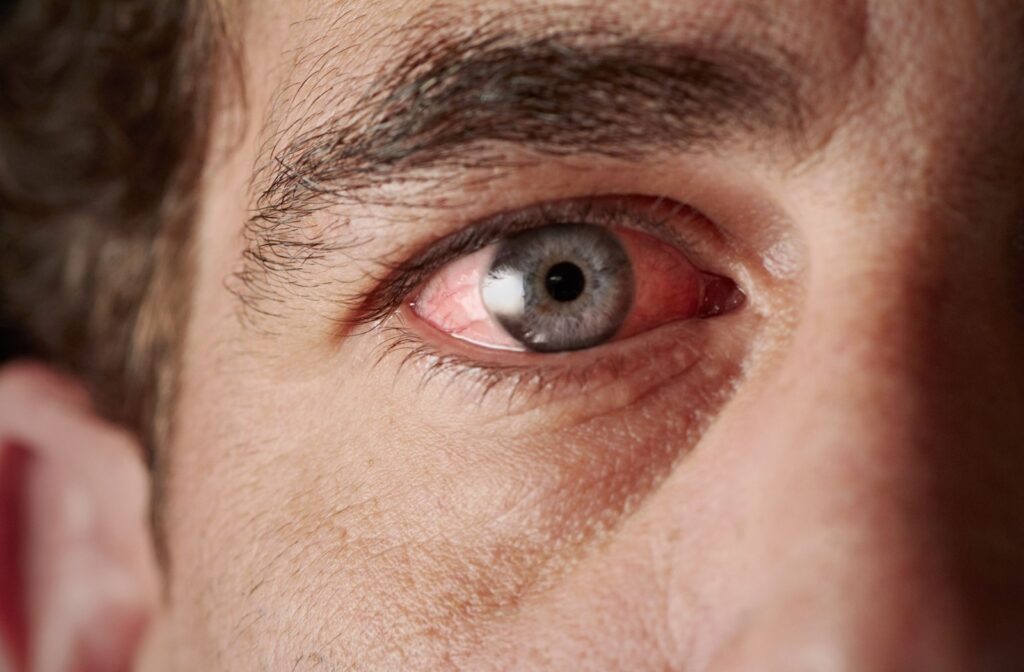Pink eye is one of the most common eye conditions, affecting millions. It’s characterized by redness, itching, and discharge. An interesting thing about pink eye is that it can often be misdiagnosed. Some conditions commonly misdiagnosed as pink eye include:
- Eye allergies
- Styes
- Dry eye syndrome
- Blepharitis
The fact that something as common as pink eye can be misdiagnosed as other common eye conditions highlights the importance of involving your eye doctor. We’ll review a few tips below on when you should book an appointment for an eye exam with your optometrist.
Understanding Pink Eye
Pink eye, medically known as conjunctivitis, is an inflammation or infection of the conjunctiva—the thin, transparent layer covering the eye’s white part and the inside of the eyelids. Viruses, bacteria, allergens, or irritants like smoke and pool chlorine can cause this condition.
Symptoms of Pink Eye
The symptoms of pink eye can vary depending on the cause but generally include:
- Redness in one or both eyes
- Itching or burning sensation
- Watery or thick discharge
- Crust formation, especially overnight
- Increased tear production
These symptoms can be uncomfortable and may lead to temporary vision blurriness.
Causes of Pink Eye
Various factors can trigger pink eye, including:
- Viral infections: These infections are often caused by the same virus responsible for the common cold.
- Bacterial infections: Bacteria from poor hygiene, sharing facial products, or towels can contribute to bacterial infection risk.
- Chemical conjunctivitis: Exposure to chemicals, pollution, or fumes can cause this type of pink eye.
Understanding these causes can help your eye doctor with accurate diagnosis and treatment recommendations.
Conditions Misdiagnosed as Pink Eye
While pink eye is common, several other eye conditions share similar symptoms, leading to frequent misdiagnoses. Here’s a rundown of some common culprits.
Allergic Conjunctivitis
Allergic conjunctivitis is inflammation caused by allergens like pollen or pet dander. Unlike viral or bacterial conjunctivitis, it isn’t contagious but can still cause significant discomfort.
- Symptoms: Eye redness, itching, and watery eyes
- Triggers: Exposure to allergens like pollen or mould
- Treatment: Usually involves antihistamines or avoiding allergens
Styes
A stye or hordeolum is a painful lump on the edge of the eyelid caused by a bacterial infection. It can be mistaken for pink eye due to redness and swelling.
- Symptoms: Painful, red bump on the eyelid, swelling, and tearing
- Causes: Bacterial infection of an oil gland
- Treatment: Warm compresses or occassionally antibiotic ointments or orals. IPL is a very effective in office treatment that can also get at the root cause of dry eye.
Dry Eye Syndrome
Dry eye syndrome, typically called dry eye, occurs when the eyes cannot produce enough tears or produce poor-quality tears. This condition can mimic pink eye symptoms but requires a different treatment approach.
- Symptoms: Redness, burning sensation, and blurred vision
- Causes: Inadequate tear production or poor tear quality
- Treatment: Artificial tears, prescription eye drops, and lifestyle changes
Blepharitis
Blepharitis is an inflammation of the eyelids, often confused with pink eye due to similar symptoms.
- Symptoms: Red, swollen eyelids, crusty eyelashes, and itching
- Causes: Bacterial infection, clogged oil glands, or allergies
- Treatment: Regular eyelid cleaning, antibiotics, or steroid eye drops
How to Differentiate
Knowing how to distinguish between pink eye and other eye conditions is crucial for effective treatment.
Assess the symptoms:
- Redness: Both pink eye and other conditions cause redness, but pink eye usually affects the entire eye.
- Discharge: Thick, yellow-green discharge suggests bacterial pink eye, while clear, watery discharge points to viral or allergic causes.
- Location of Redness: If the redness is confined to the eyelid margins, it could be blepharitis or a stye.
Consider the context:
- History of Allergies: You might be dealing with allergic conjunctivitis if you have a history of allergies.
- Exposure: Recent exposure to someone with pink eye increases your risk.
- Duration: Pink eye typically resolves within a week, while other conditions may persist longer.
Evaluate the discomfort:
- Pain: Severe pain is more likely to be a stye or another serious condition.
- Itching: Prominent in allergic conjunctivitis, less so in bacterial or viral pink eye.
- Foggy vision: Significant vision changes necessitate a professional consultation.
When to Seek Professional Help
Consulting an eye care professional is always a wise decision when in doubt. But a few recommendations on when to book an appointment are:
- Persistent symptoms
- If redness doesn’t improve within a week
- Severe pain could indicate a more serious condition
- Vision changes like blurred vision or light sensitivity
Book an Eye Exam Today
Understanding the nuances of eye conditions can save you time, discomfort, and potential complications. While pink eye is common, several other conditions share its symptoms, making accurate diagnosis crucial. By knowing how to differentiate and when to seek professional help, you can ensure proper treatment and maintain optimal eye health.
Don’t hesitate to call our professional team at Collingwood Optometry & Cwood Eyecare today if you have any concerns about your eyes. We can offer personalized advice and schedule you to see one of our experienced optometrists. Following a thorough examination of your eyes, we can provide tailored treatment advice.























